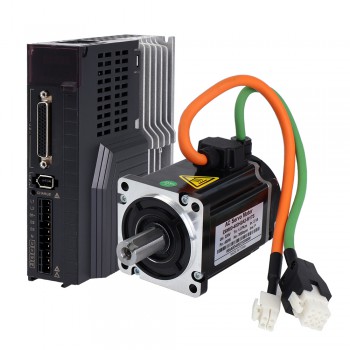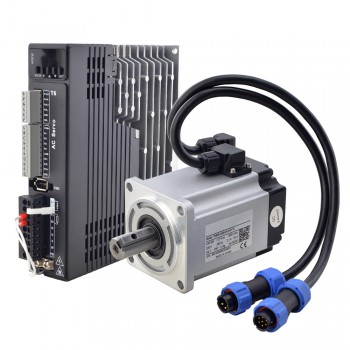AC servo motor VS DC servo motor from Minnie's blog
1.Introduction
As the core driving component in the field of modern industrial automation, servo motors are widely used in various high-precision and high-performance control systems. According to different power supply methods, servo motors can be mainly divided into two categories: AC Servo Motor and DC Servo Motor. There are significant differences between the two in terms of working principles, control methods, application fields and performance characteristics. This article will discuss and compare the differences between AC servo motors and DC servo motors in detail.

2.Working principle
AC servo motor
AC servo motors are powered by AC power and their working principle is based on the law of electromagnetic induction. When voltage is applied to the stator winding, the servo motor will soon start rotating. The current flowing into the excitation winding and control winding generates a rotating magnetic field in the motor, and the direction of the rotating magnetic field determines the direction of the motor. When the voltage applied to any winding is reversed, the direction of the rotating magnetic field changes, and the direction of the motor also changes. AC servo motors usually include induction servo motors and permanent magnet synchronous servo motors.
DC servo motor
DC servo motors are powered by DC power and their working principle is based on the law of electromagnetic force. The DC servo motor achieves torque output through the interaction of DC current between the stator coil and the rotor coil, and its speed can be adjusted by the voltage. DC servo motors include two types: DC brush servo motors and DC brushless servo motors. Brush DC servo motors have low cost, simple structure, large starting torque, and wide speed range, but have high maintenance costs and are prone to electromagnetic interference; brushless DC servo motors have small size, light weight, large output, and fast response. , high efficiency and other advantages, suitable for various environments.
3.Control method
AC servo motor
AC servo motors usually use closed-loop control systems, which include position feedback sensors (such as encoders) and controllers. The controller realizes closed-loop control by reading the encoder signal and comparing it with the preset target position to adjust the movement of the motor. This control method makes the AC servo motor have the characteristics of high precision, high response speed and high stability.
DC servo motor
DC servo motors can use open-loop control or closed-loop control. In open-loop control, the motor speed is adjusted according to the size and polarity of the input signal. In closed-loop control, the motor performs position control through the position feedback signal returned by the encoder. The control method of DC servo motor is relatively flexible and can be selected according to specific needs.

4.Application areas
AC servo motor
AC servo motors are widely used in industrial automation, machine tools, printing, textiles, robots and other fields. Its high-speed response and high power density make it suitable for high-precision and high-performance applications. For example, in CNC machine tools, AC servo motors can achieve high-speed, high-precision positioning and cutting; in the field of robots, AC servo motors are used to achieve precise control and flexible movement of robots.
DC servo motor
DC servo motors are widely used in robotics, medical equipment, aerospace and other fields. DC servo motors have good speed and position control performance and are widely used in applications requiring precise control and response speed. For example, in medical equipment, DC servo motors are used to achieve precise surgical operations and patient monitoring; in the aerospace field, DC servo motors are used to achieve precise control and navigation of aircraft.
5.Performance characteristics
AC servo motor
AC servo motors have the characteristics of high precision, high response speed, and high stability. Its multi-phase pole form enables the motor to have better torque smoothness and operating stability. In addition, the manufacturing cost of AC servo motors is relatively low, and there are many manufacturers, so the price is relatively cheap.
DC servo motor
DC servo motors have the characteristics of high precision, high response speed, and good dynamic performance. Among them, the brushless DC servo motor also has the advantages of small size, light weight, large output, fast response, and high efficiency. However, the manufacturing technology and maintenance costs of DC servo motors are relatively high, and they are easily affected by external factors such as temperature and voltage.
6.Summary
There are significant differences between AC servo motors and DC servo motors in terms of working principles, control methods, application fields, and performance characteristics. Selecting the type of servo motor suitable for a specific application depends on the specific application requirements and performance specifications. In practical applications, it is necessary to select the appropriate servo motor type according to specific needs and conditions to achieve the best control effect and economic benefits.
Source:https://www.storeboard.com/blogs/electronics/ac-servo-motor-vs-dc-servo-motor/5853599

The Wall